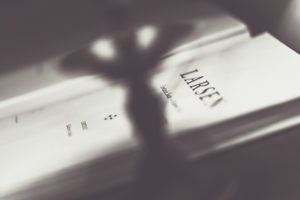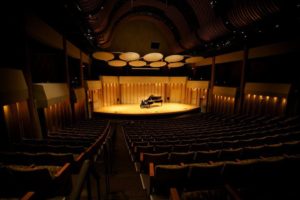Dr. Mark Howard, PhD
The nine volumes here, collectively titled Fantasia Suite, constitute the complete body of original solo piano music, of composer Carter Larsen (b. 1955). His work as a pianist spanned several countries and covered many composers, including Franz Liszt (1811–86), Frédéric Chopin (1810– 49), Camille Saint-Saëns (1835–1921), and Sergei Rachmaninoff (1873–1943). These experiences have meaningfully contributed to the inspiration for and practical development of his work.
His intimate knowledge of piano performance is evident in the careful attention paid to expression markings throughout the scores. For all their wealth of detail and individuality, these pieces are unified by Larsen’s profound compositional aesthetic. His wide emotional palette, central to music of the eighteenth and nineteenth centuries, has led contemporary composers and musicologists to cat
 egorize Larsen as “Neo-Romantic;” however, the composer’s free use of chords and tonalities for their distinctive colors and sonorous prop-erties also emphasizes an unparalleled lyrical beauty, refinement, optimism and boldnes.
egorize Larsen as “Neo-Romantic;” however, the composer’s free use of chords and tonalities for their distinctive colors and sonorous prop-erties also emphasizes an unparalleled lyrical beauty, refinement, optimism and boldnes.
Larsen’s compositional style reflects his life-long engagement with and technical mastery of music from a range of styles, provenances, and historical periods. These include the Baroque, Romantic, and Classical Eras, popular music, jazz, Latin-American music, and twentieth-century Minimalism.
Larsen’s piano music is greatly influenced by careful studies of the keyboard music of Johann Sebastian Bach (1685– 1750) and Wolfgang Amadeus Mozart (1756–91), particularly the former’s Well-Tempered Clavier (Book I [1722], Book II [c. 1740]) and the latter’s solo piano music (sonatas, sets of variations, and fantasies). Larsen’s shorter works (e.g. Innocence op. 17, Soliloquy op. 10, The Spirit of Auriel op. 28) owe their economy of ideas and heightened drama to the preludes of Bach and ultimately those of Chopin (op. 28 [1838–39]).
However, beyond mere character in Larsen’s and Bach’s music lies a skillful and astute handling of counterpoint and part movement. When one considers the rhythmic complexity of Larsen’s music, a feature illustrated by a multi-layered texture of duple and triple divisions of the beat (Eternal Rhapsodie op. 4), mixed meter (Bridges op. 3), ornamentation (Soliloquy op. 10), figurations of quintuplets, septuplets, etc., and syncopation (The Call of Asturias op. 66 and Firestorm op. 69), it becomes clear that his approach to part layout is not only sophisticated but highly innovative.
Mozart’s music similarly offers a balanced and simple texture that unassumingly illustrates a careful and exacting hand, one whose inspiration and dramatic pace seem effortless yet profound. Larsen’s Bridges op. 3 exemplifies this compositional strategy by its sparse, contemplative opening and gradual build-up of musical momentum. In the manner of Mozart, Larsen not only clearly demarcates the structural divisions in his works but develops his melodies or phrases through sequential motion, repetition at various pitch levels, a combination of irregular phrase lengths, and the interspersal of ornamental figurations and techniques which are also effectively employed by Chopin.
 The influence of Liszt and Chopin on Larsen’s music is evident throughout his works in several distinctive ways, most notably in the idiomatic writing for piano. Larsen effectively exploits the resources of the instrument through range and register, textural variety, unpretentious virtuosity (Santorini op. 35), chordal density (Spinato op. 68), and a multitude of figurations (Dragonfly op. 46), which ubiquitously appear in nineteenth-century piano works such as etudes and concertos (e.g. Liszt’s Concert Etudes and Edvard Grieg’s [1843–1907] Piano Concerto in A minor op. 16 [1868], a work Larsen performed frequently including both the Royal Philharmonic Orchestra and London Symphony Orchestra.)
The influence of Liszt and Chopin on Larsen’s music is evident throughout his works in several distinctive ways, most notably in the idiomatic writing for piano. Larsen effectively exploits the resources of the instrument through range and register, textural variety, unpretentious virtuosity (Santorini op. 35), chordal density (Spinato op. 68), and a multitude of figurations (Dragonfly op. 46), which ubiquitously appear in nineteenth-century piano works such as etudes and concertos (e.g. Liszt’s Concert Etudes and Edvard Grieg’s [1843–1907] Piano Concerto in A minor op. 16 [1868], a work Larsen performed frequently including both the Royal Philharmonic Orchestra and London Symphony Orchestra.)
Larsen also interweaves short cadenzas using figurations that span a large range of the keyboard and have their origins in the bel canto operas of Vincenzo Bellini (1801– 35) and Gaetano Donizetti (1797–1848). For example, Larsen uses this technique to build dramatic tension in the rhapsodic Flight op. 7.
These features are always sincerely employed by Larsen in the service of the subject of the work, and never delve into excess. The compositional technique of thematic transformation, particularly associated with the music of Liszt and in which a melodic idea is manipulated and reshaped, is also apparent. This technique is employed to unify large-scale works, and eschews the basic alternation of sections devoted to a single idea mostly found in the Classical and Romantic sonata. Larsen combines all the above techniques, allowing the listener to identify a piece’s subject while tracing its development and potential for cultivation over the course of the work.
Large-scale drama throughout Larsen’s oeuvre is reflected in the gargantuan Santorini op. 35 and Mass Ascension op. 9, both notable works in this regard. Volumes Six through Eight of this edition offer a trilogy in the spirit of Richard Wagner’s Der Ring des Nibelungen (1851–76).
Rhythms, harmonies, and compositional techniques of all the various genres of music mentioned above are to be seen throughout Larsen’s work. Minimalism, for instance, is rooted in Larsen’s studies at the San Francisco Conservatory with highly influential American composer John Adams (b. 1947), who is the dedicatee of Larsen’s Ratanga op. 61 and whose operas and works for orchestra and piano are recog- nized as cornerstones of American music of the second half of the twentieth century. Larsen’s sensitivity to and recognition of the listener’s crucial role in performance, something absent from the aesthetic criteria of many composers of twentieth- and twenty-first century Art Music, also partially has its roots in Adams’ work. Minimalist techniques such as the gradual building up of musical texture through layering and extended sections of repetition of a basic musical element are present, enhancing the listener’s ability to fully understand and feel how the subject is expressed (see the opening to Reverence op. 36 or Spectre op. 40).

Larsen’s use of syncopated sixteenth-note figures in Tale of Velasco op. 72 and Sirens in Trancoso op. 62 reflects his interest in the rhythms of rock and popular music. Harmonic progressions of seventh, ninth, and suspended chords, such as those found in Iris op. 107 and Solstice op. 12, and a strong improvisatory style reveal a kinship to jazz that Larsen adapts and cultivates within his own compositional language.
Larsen effortlessly juxtaposes all of his influences to shape and profoundly impact each other in a unique style. For example, nineteenth-century lyricism, so prevalent in the primarily conjunct melodies of the nocturnes of Chopin and coupled with an undercurrent of arpeggios, dialogues with a section based on bossa nova rhythms and harmonies in Sapphire op. 47.
The distinctive blend of such seemingly unrelated styles and genres allows Larsen to create a vivid and evocative picture for his listeners. This approach seems rooted in studies of Gustav Mahler’s (1860–1911) symphonies, which sometimes juxtapose such elements as folk song, idyllic imagery, and simple melodic beauty with the horrors of funeral marches, personal tragedy, and doomed fate.
This edition presents the definitive text (i.e. Urtext) for each work, guaranteeing performers authoritative source material and insight, demonstrating how Larsen intends each musical idea to be expressed. His abundance of expressive, dynamic, articulation, metronome and pedal markings throughout the scores is of true importance.
As with the work of any great composer, these works vary in their level of difficulty, but only for the sake of expression and the communication of extra-musical subject matter. Larsen’s music draws on a rich tra- dition of historical masterpieces, disparate styles, and genres and while the pieces cited above exemplify many aspects of compositional approachs, different qualities may be seen throughout these Volumes that transform Fantasia Suite into an original and groundbreaking new style.
The significance of this collection on the culture of classical music cannot be overstated. Larsen’s volumes of solo piano music impact classical music’s identity to twenty-first century audiences, who will find that its focus is vital and culturally relevant. This collected edition marks an important and large contribution to the solo piano repertoire through its aesthetic vision, originality, and legacy.
Dr. Mark Howard, PhD

